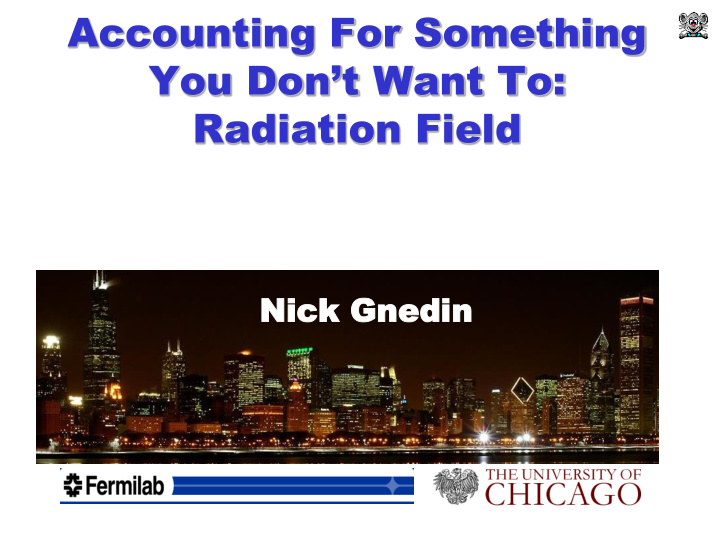



Accounting For Something You Don’t Want To: Radiation Field Ni Nick Gnedin ck Gnedin
Why We Need To Unless we are modeling reionization, we do not really want to add an RT solver to our code… We also do not need to – reionization has little effect on star formation in galaxies.* There are 3 physical effects that must account for the radiation field: • Molecular hydrogen formation • Gas cooling and heating • Radiation pressure * And yes, claims to the contrary that you might have heard are wrong!
HI-H 2 Transition There exist several models for that transition, all mutually compatible. Molecular gas determines star formation rate, atomic gas does not.
HI-H 2 Transition One small correction: line overlap enhances H 2 formation in very low metallicity environments. (Gnedin & Draine 2014)
HI-H 2 Transition Dependence of the HI-H 2 transition on radiation field is weak, only ~ logarithmic for RF like in the Milky Way and stronger. Hence, one does not need to know the radiation field very precisely.
Cooling Function 101 Most general cooling and heating functions: One needs a code like Cloudy to compute L in its full glory.
Cooling Function 101 Simplification #1: optically thin Simplification #2: ionization/excitation balance Often, this is what is actually called a “cooling function”.
Sunny Places are Warm log 10 (U) = -3 log 10 (U) = -2.5 log 10 (U) = -2 log 10 (U) = -1.5 log 10 (U) = -1 log 10 (U) = -0.5 log 10 (U) = 0 log 10 (U) = 0.5 log 10 (U) = 1 log 10 (U) = 1.5 log 10 (U) = 2 log 10 (U) = 2.5 log 10 (U) = 3
Cute Example A host halo of a quasar: No cooling at all – novel feedback mechanism!
Does It Really Matter? Proximity zones around galaxies are not large. Cooling/heating functions are strongly RF dependent only in the ISM.
99.9999% Of the Volume Is Easy When the cosmic background dominates ( ): … Wiersma, Schaye, & Smith 2009 …
00.0001% Of the Volume May Not Matter We never model stellar feedback, we always model SF+feedback together.
In A Relationship Both Sides Matter Blastwave with t BW =30Myr 3/2 model Linear model
00.0001% Of the Volume May Not Matter We never model stellar feedback, we always model SF+feedback together. SF Feedback One can just add cooling to the pool. Cooling SF Feedback In fact, that’s what most people actually do!
If You Are Stubborn: RT-Lite Disk galaxies are RT solvers.
If You Are Stubborn: RT-lite Climb the tree to the right branch. MFP MFP
Conclusions How to include radiation fields in galaxy formation simulations? Don’t. In the worst case when you must, use a simple estimate and your code tree data structure: RF = SFR within the MFP.
The End
Recommend
More recommend